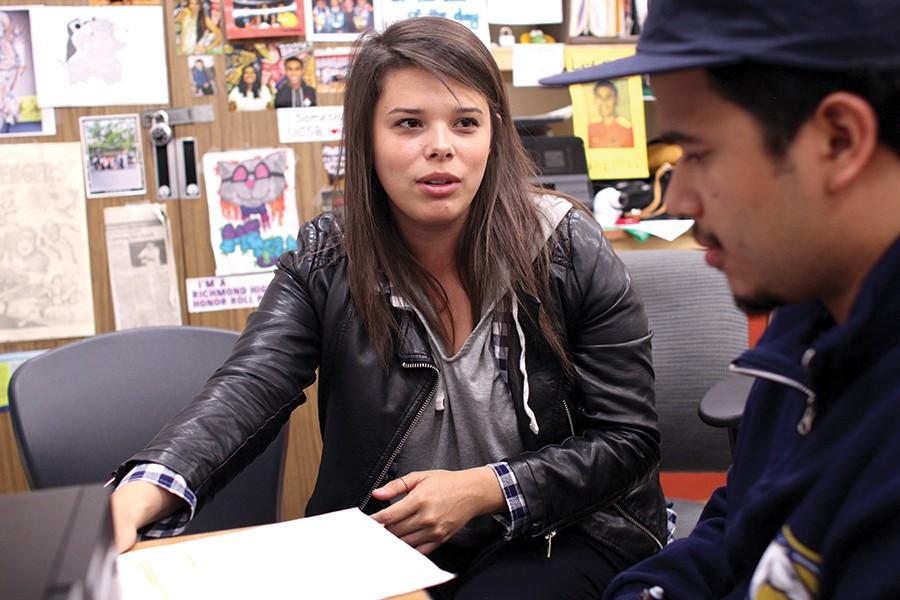City Council extends Richmond Promise
City officials set $1,500 as cap for all students seeking Chevron’s support program
Christian Urrutia / The Advocate
Angelica Arriaga, program director for College is Real, a college readiness program, gives advice to Richmond High school graduate Marvin Parra in the College and Career Center at Richmond High School on Monday.
Dec 9, 2015
The Richmond City Council finalized the requirements for its graduating high school residents to take advantage of Chevron’s $35 million Richmond Promise scholarship program.
According to its website, on Nov. 17 the council approved that starting in 2016, all Richmond residents who graduate high school in the West Contra Costa Unified School District (WCCUSD) are eligible to receive up to $1,500 for their initial year in college — regardless if they choose to go to a four-year university or community college.
Interim Contra Costa College President Mojdeh Mehdizadeh said the original wording in the Richmond Promise was not as inclusive as the recent council ruling.
Mehdizadeh said the Richmond Promise initially gave graduating high school students enrolling into a four-year university the opportunity to apply for up to $2,500 while students enrolling into community college could only get up to $500.
“I wrote a letter to the city council saying that the allocations were not equitable,” she said. “Some students are not ready to go to a four-year and if we want to promote student success then we need to provide equity and make it $1,500 for all students.”
At CCC there are two functioning high schools, Middle College High School and Gateway to College.
Both are K-12 institutions that provide their students the opportunity to experience a college atmosphere while taking classes that count toward a student’s major.
MCHS Principal Anne Shin said the Richmond Promise will benefit most of its 300 students.
“Any money for our students is good,” Shin said. “Especially for our students who are concerned about how they are going to pay for college with their financial situation.”
MCHS senior Kathia Arias said she wants to study economics at UC Santa Cruz next year, which would cost about $13,000 per year.
“I would definitely use the money. I need all the (financial) help I can get,” Arias said. “I plan on working a lot of jobs because I cannot get a lot of financial aid because I cannot legally — I am an undocumented student.”
Arias said when she was 4 years old her parents brought her with them when they left Mexico.
“Because I fall under (Deferred Action for Childhood Arrivals) DACA, I cannot apply for financial aid that asks for a social security number, so my options are limited,” she said.
“If I could avoid taking out student loans by working three jobs instead, I would because it is hard for people coming out of college to pay off student loans, especially with the low economy and high interest rates — it’s a lot to handle.”
Mehdizadeh said Dean of Enrollment Dennis Franco, Director of Economic and Workforce Development Kelly Schelin, HIS-STEM Grant and Metas Program Director Mayra Padilla and Dean of Student Services Vicki Ferguson met with city officials Bill Lindsay, city manager, and Shasa Curl, administrative chief, on Wednesday to discuss the changes made and the implementation of the Promise.
Shinn said that she is grateful Richmond City Council approved that Chevron would fund students going to four-year universities the same amount as those going to a community college.
Mehdizadeh said, “A lot of work still needs to be done” regarding how students will be informed that they can apply for the Richmond Promise, she said it provides and equitable foundation for Richmond resident students to pursue higher education they could not otherwise.
“UCs, CSUs or private colleges are much more expensive,” she said. “Students get more bang for their buck if they come to CCC for their first two years of general education — I mean why not? There are smaller class sizes, the teaching is more hands-on, there is a warm and diverse atmosphere that prepares students for a four year — and it saves them a considerable amount of money.”



